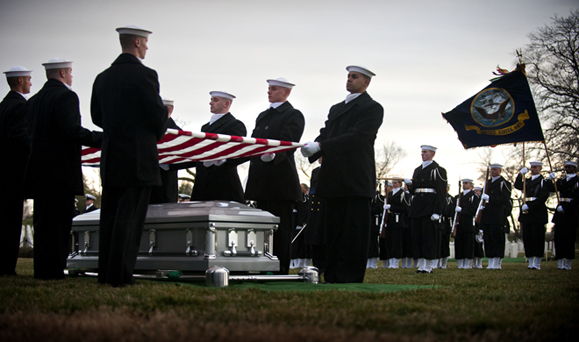What will likely be the last burial of the U.S. Civil War took place at Arlington National Cemetery on March 8. Two sailors whose skeletons were found in 2002, when the gun turret of the sunken USS Monitor was unearthed off the coast of Cape Hatteras, North Carolina, were finally laid to rest in a full naval ceremony.
Speaking at the funeral service, Navy Secretary Ray Mabus said, “Today is a tribute to all the men and women who have gone to sea, but especially to those who made the ultimate sacrifice on our behalf.” His speech touched upon the largely symbolic nature of the ceremony, as after ten years of intensive research, the identities of the men remain unknown.
The Monitor, which shipped out of Brooklyn in January 1862, made history when its battle against the Confederate CSS Virginia on March 9, 1862 marked the first-ever hostile encounter between two ironclad warships. The battle was a draw and the Monitor survived, but almost nine months later the ship sank in rough seas, killing sixteen sailors.
The names of those sixteen are known, but forensic specialists and genealogists have been unable to conclude which two of the sixteen men were trapped in the gun turret as the ship went down.
“The Monitor sailors were really very unusual for us; water recoveries first of all are not that common,” said Robert Mann, director of the Forensic Science Academy for the Joint POW/MIA Accounting Com-mand, which works to repatriate and identify fallen members of the military “To recover remains from the bottom of the ocean that sat there for 150 years is really phenomenal.”
The lost 16 sailors have been described as a cross section of mid-19th-century America: two Irishmen; three African Americans; others from Scotland, England, and Wales; one from Maine.
After the initial discovery in 2002, Mann and his team set about trying to identify the two men. Once the bones were desalinized and cleaned, a process that took several months, Mann was able to examine the remains and establish biological profiles of the two sailors. The profiles, based primarily on their bones and teeth, concluded that the sailors were both white males. One was 17 to 24 years old; the other was in his 30s. Both were about 5 foot 7 inches tall. From there, the team narrowed it down to six out of the sixteen, and genealogists were able to find living relatives for 10 of the 16, but no DNA samples to date have provided any clear connection.
While others among the crew have been highlighted as likelier candidates, it is possible that one of the skeletons is that of Galway man Thomas Joice (also spelled Joyce), who emigrated from Ireland around 1858 and enlisted in the U.S. Navy in January 1862. As genealogist Megan Smolenyak discovered, his European ancestry and skill as a fireman make it possible that he would have been in the gun turret at the time the ship sank, but his taller than average (for the time) height of 5 feet 9 inches conflicts with Mann’s conclusions about the heights of the sailors.
A marker with the names of all sixteen will be placed on the spot where the remains were buried, and the JPAC will continue efforts to discover their identities.
“We will never give up trying to identify these Sailors,” said Mann. His colleague, Sgt. Mag. Danang McKay, added “It gives the family closure, and I think it gives the war fighter a sense of comfort to know that no matter what happens, the nation has not forgotten them and will return them back home with honor.”
USS Monitor Sailors Laid to Rest

Two sailors recovered from the ironclad USS Monitor are buried with full military honors at Arlington National Cemetery. U.S. Navy photo by Mass Communication Specialist 2nd Class Todd Frantom.

Leave a Reply